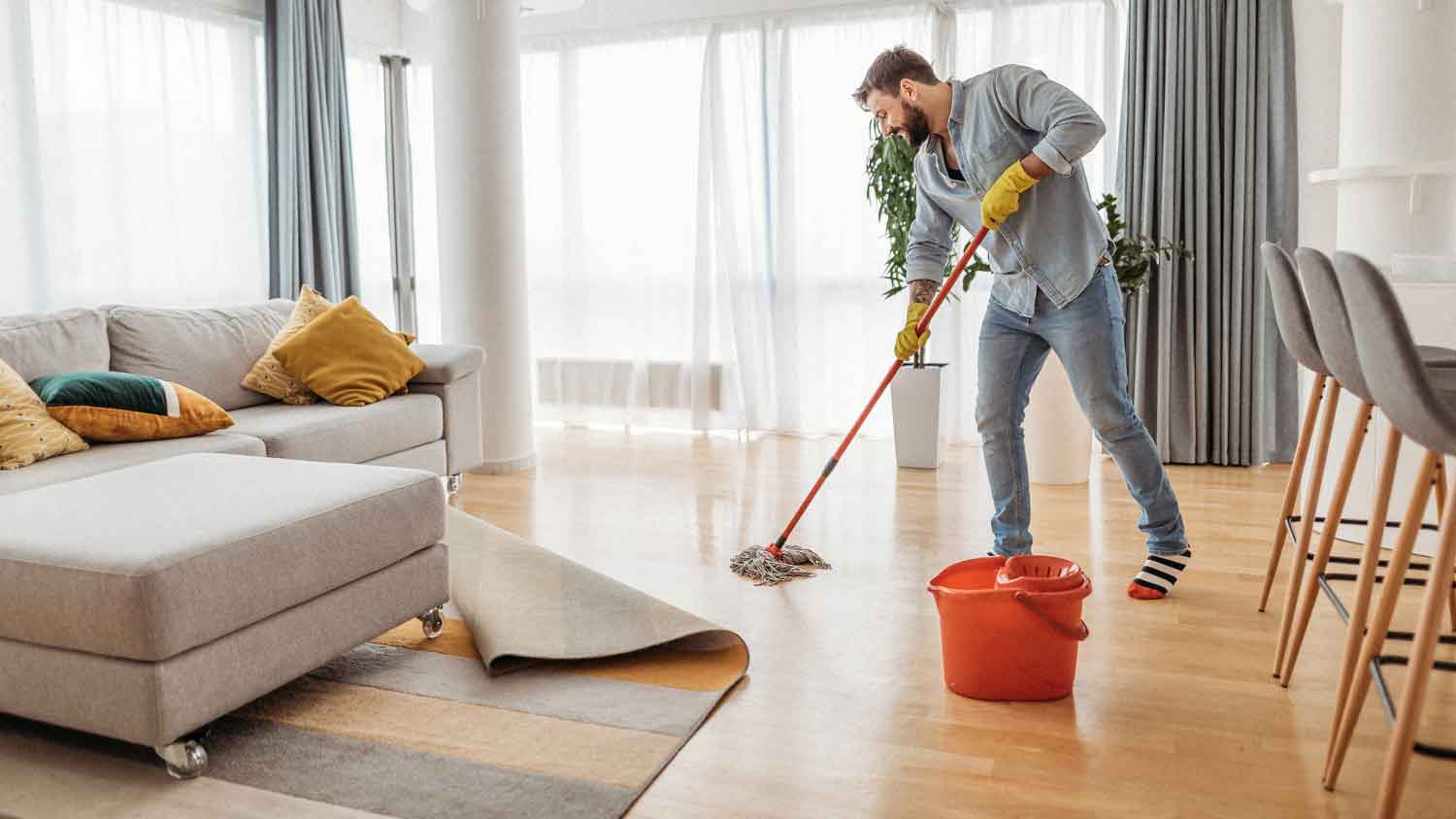How Much Does Tile and Grout Cleaning Cost? [2025 Data]
The average tile and grout cleaning job costs between $284 and $674, but prices can vary depending on the size of your space and type of grout.


It’s important to keep the tile in your home clean—not only to maintain its beauty but also for sanitary purposes. At a minimum, you should clean your grout at least once a year to keep it white. Hiring a cleaning professional to take care of your tile and grout can cost anywhere between $284 and $674, with the national average cost of $479.
Tile and Grout Cleaning Cost Factors

Here are the main cost factors to consider when determining the cost of tile and grout cleaning.
Size of Room
It costs between $0.50 to $3 per square foot to have your tile and grout cleaned, with a $100 to $200 minimum. These costs typically include labor and material costs, so no need to worry about paying extra.
| Room | Size by Square Foot | Average Cost |
|---|---|---|
| Kitchen (small) | 100 | $50–$300 |
| Kitchen (large) | 240 | $120–$720 |
| Bathroom | 60 | $30–$180 |
| Living room | 340 | $170–$1,020 |
Size of Tile
Your tile size can impact your cleaning costs. The smaller the tile, the more grout you will have to clean. If your cleaner uses a hand-held cleaning method and charges by the hour, it will take them longer to clean smaller tiles than bigger tiles.
Also, bigger slab tiles require extra care when cleaning. Using the wrong cleaner on a slab tile could damage the entire tile, which could be costly to replace. Your cleaner may charge different prices based on the materials needed to clean your specific tile.
Hourly Rate
Professional cleaners charge between $30 and $50 per hour for tile and grout cleaning. Keep in mind that many companies have a $100 to $200 minimum, so expect to pay at least $100 to call someone out to your house.
Tile and Grout Condition
Sometimes, life gets the best of us and we forget to tend to the details. If your tile and grout haven’t been cleaned in a long time, your cleaner may charge an extra $100 to $200. This helps account for the extra work and time it will take to get your tiles and grout back in good, sparkling condition.
Cleaning Method
Your cleaner will charge different prices according to the cleaning method.
Chemical Hand Cleaning
Depending on the amount of cleaning your tile and grout need, your cleaner may opt for chemical hand cleaning. Your cleaner will get all the dirt and grime out of the grout lines using a commercial-grade cleaner and a grout brush. They’ll also scrub your tiles clean.
This costs $0.50 to $3 per square foot, and it’s the best option for cleaning small tiled areas.
Steam Cleaning
Steam cleaning costs $0.50 to $3.50 per square foot. You might prefer this method if you’re sensitive to chemicals because the steam method only uses water. It’s also a good option for cleaning big spaces.
Frequency
The best time to clean tile and grout is when you schedule a deep cleaning, which should be at least one to two times a year. This should suffice as long as you’re regularly cleaning your tiles on a weekly basis, which helps prevent a build-up of dirt and grime. Remember, the easier it is to clean, the less time your grout cleaning pro needs, which costs you less.
Labor
You can expect to pay your tile and grout cleaner $0.50 to $5 per square foot for their labor. The materials they use for cleaning are typically included in their labor rates.
Cost to Clean Tile by Type of Service
There’s a lot more to tile and grout cleaning than you might expect. Here are some services and costs to consider.
Cost to Steam Clean Tile Floors
Contractors use commercial-grade, high-pressure steamers that get the job done efficiently, even in large spaces. This service costs $0.50 to $3.50 per square foot. It’s a great option for many people because it can clean up heavy buildup.
Cost to Clean and Seal Tile and Grout Flooring
Sealing your tile and grout helps them last longer. Tiles should be sealed every three years and grout should be sealed after every cleaning. Grout cleaning should be done once or twice a year. The cost for cleaning and sealing tile and grout flooring is $0.75 to $5 per square foot.
Grout Restoration
Your grout condition will determine if you need to repair or restore it. Restoration costs less, about $1 to $4 per square foot, while repair is $3 to $25 per square foot.
During the grout restoration process, the pro will either fix and fill in any small cracks or loose joints, or they’ll remove the top layer of grout and install fresh grout in its place.
Grout repair, on the other hand, requires the pro to remove the existing grout and start fresh with a new batch of grout.
Additional Costs to Consider
Check to see if you need any of these additional services for your tile and grout.
Flat Rate Cleaning Fees
Some tile and grout cleaners will charge a flat rate cleaning fee. Before you agree to the amount, check and see what’s included. Usually, these fees are $150 to $500 and can include services such as:
Steam cleaning
Tile repair
Grout repair
Recaulking
Grout recoloring
Sealer
Mold treatment
Tile Repair or Refinishing
If your tile needs repairs, expect to pay $1 to $50 per square foot depending on the material. The most common tile types, like ceramic and porcelain, cost $1 to $15 per square foot to repair. Natural stone repair costs more, ranging between $5 and $50 per square foot.
If you’re looking to DIY the job, you may be able to learn how to fix cracked tile. You have a better chance of this if you’re dealing with something minor like a thin crack or small chip.
You may also want to get your tiles refinished if you’d like them to look as good as new again. This costs $4 to $12 per square foot. This is a great option if you’re looking to remodel but don’t want to necessarily pay tile installation costs.
Recoloring Grout
While you’re getting your tile and grout cleaned, you might opt to recolor the grout. The colorant usually also acts as a sealer, so you’re not going to be adding any extra steps. However, it does take patience and time to get this done since you have to do this job manually.
Glazed ceramic or porcelain tiles are the best for recoloring grout. They cost $1 to $2.50 per square foot.
Cost to Clean Tile and Grout Yourself

Learning how to clean floor tile and grout is something any DIYer can take on with the right tools. You’ll need a bristle brush and sealant, found at your local home improvement store, and soapy water. If you clean it yourself, read the labels to make sure the chemicals are fine to use on your tile and grout. Heavy-duty cleaners, like acid-based cleaners, can ruin your tile floors.
DIY Tile and Grout Cleaning Costs vs. Hiring a Contractor
If you decide to go the DIY route, you can grab cleaning tools and sealant from your local hardware store, which will cost around $25 for basic tools or up to $200 for advanced tools that make the job even easier. You can also invest in a grout cleaning kit for $20 to $100. The DIY method will definitely save you money.
If your home flooring is mainly tile or grout, take a day and clean it yourself since the area needing to be cleaned, as well as the grout’s condition, are the main factors that influence price.
Though a pro will cost you more up front, between $300 to $500 per room, they’ll save you a lot of time, backache, and potential damage. Also, by not having your grout and tile cleaned properly you can experience major respiratory problems if bacteria and mold exist within the tile and grout in your home. Having a professional clean your grout and tile will ensure that the right cleaning practices are put in place so that you can enjoy your tile and grout longer.
4 Ways to Save on Tile and Grout Cleaning
Want some top tips to save money on tile and grout cleaning costs? Here’s what you should do:
Compare Quotes: Getting three quotes from local tile and grout cleaning pros is a great place to start. Don’t forget that the lowest quote isn’t always the best one. Make sure to take into account all of the services offered for the price.
Consider Bundling: Some cleaners offer discounts for bundled cleaning services. If you have more areas in your house that you need to clean anyway, ask your pro what their offer would be if you bundled.
Try to DIY: DIYing this job isn’t for everyone, especially those with back or leg issues or mobility challenges. However, if you have the time, cleaning your tile and grout is the best way to save money.
Buy a Cleaning Kit: If you DIY, you may save even more in the long run by buying a cleaning kit. Investing in a high-quality kit means that you’ll have an easier time doing the job and won’t have to spend money to replace lower-quality tools every time your tile and grout need a deep clean.
How Angi Gets Its Cost Data
Home is the most important place on earth, which is why Angi has helped more than 150 million homeowners transform their houses into homes they adore. To help homeowners with their next project, Angi provides readers with the most accurate cost data and upholds strict editorial standards. We’ve surveyed thousands of real Angi customers about their project costs to develop the pricing data you see, so you can make the best decisions for you and your home. We pair this data with research from reputable sources, including the U.S. Bureau of Labor Statistics, academic journals, market studies, and interviews with industry experts—all to ensure our prices reflect real-world projects.
Want to help us improve our cost data? Send us a recent project quote to costquotes@angi.com. Quotes and personal information will not be shared publicly.
Frequently Asked Questions
Use a bristle brush and sealant with soapy water. Make sure to read the labels because some chemicals will ruin your floors.
You should clean your grout at least once a year, if not twice. Cleaning your grout regularly will help keep your tiled rooms looking their best. Plus, proper maintenance helps your tiling last as long as possible while keeping any mold or mildew at bay.
Neglecting grout maintenance can lead to damage to your tiles including cracks. That, in turn, can cause water damage or other issues that can require a costly tile replacement.
After cleaning your grout, you should let it dry for at least 24 hours to make sure all of the moisture has evaporated before doing any resealing. Sealing your grout before it’s completely dry will lead to even more work because you’ll have to do it all over again. The sealant won’t stick to damp grout; it will just peel off.
Unless you have epoxy grout, you should reseal your grout after cleaning. This is especially true if you’re in a high-moisture area like your bathroom or kitchen. Sealing your grout has a lot of advantages, like helping your tiles last longer and making it easier to clean the grout the next time.
If you happen to skip this step, you’re likely to have grout problems down the road like cracking or grout falling out. You may also notice damage to your tiles.
















